
Asplenium is a genus of about 700 species of ferns, often treated as the only genus in the family Aspleniaceae, though other authors consider Hymenasplenium separate, based on molecular phylogenetic analysis of DNA sequences, a different chromosome count, and structural differences in the rhizomes. The type species for the genus is Asplenium marinum.

Adiantum, the maidenhair fern, is a genus of about 250 species of ferns in the subfamily Vittarioideae of the family Pteridaceae, though some researchers place it in its own family, Adiantaceae. The genus name comes from Greek, meaning "unwetted", referring to the fronds' ability to shed water without becoming wet.
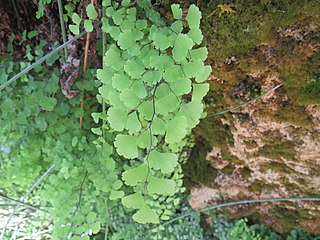
Adiantum capillus-veneris, the Southern maidenhair fern, black maidenhair fern, maidenhair fern, and venus hair fern, is a species of ferns in the genus Adiantum and the family Pteridaceae with a subcosmopolitan worldwide distribution. It is cultivated as a popular garden fern and houseplant.

Adiantum diaphanum, the filmy maidenhair fern, is a species of fern in the genus Adiantum, native to East Asia and Australasia, from southern Japan south to New Zealand. It grows to 20 cm long at the most, with very dark green fronds covered with bristles.

Adiantum aleuticum, the western maidenhair fern or Aleutian maidenhair, is a species of deciduous fern in the genus Adiantum.

Adiantum bellum is a species of fern in the family Pteridaceae, and is native to Bermuda.

Asplenium trichomanes, the maidenhair spleenwort, is a small fern in the spleenwort genus Asplenium. It is a widespread and common species, occurring almost worldwide in a variety of rocky habitats. It is a variable fern with several subspecies.

Adiantum pedatum, the northern maidenhair fern or five-fingered fern, is a species of fern in the family Pteridaceae, native to moist forests in eastern North America. Like other ferns in the genus, the name maidenhair refers to the slender, shining black stipes.
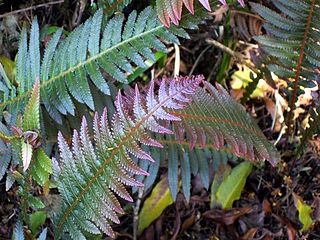
Doodia aspera, commonly known as prickly rasp fern, is a widespread and common plant, growing in eastern Australia. Often seen in rainforest margins or eucalyptus forest in Victoria, New South Wales and Queensland, it is a terrestrial fern with reddish new growth.
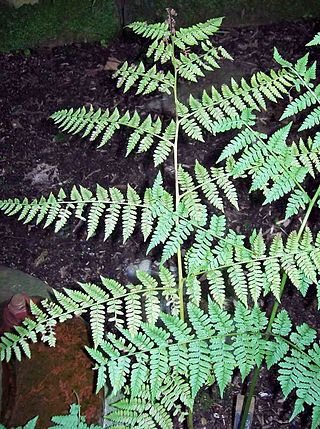
Diplazium australe, commonly known as the Austral lady fern, is a small fern occurring in eastern Australia, New Zealand and Norfolk Island. The habitat is moist shaded areas, often occurring in rainforest.

Gleichenia dicarpa, commonly known as pouched coral fern or tangle fern, is a small fern of the family Gleicheniaceae found in eastern Australia, New Caledonia and New Zealand. It forms tangled thickets in wet places such as swamps and riverbanks.
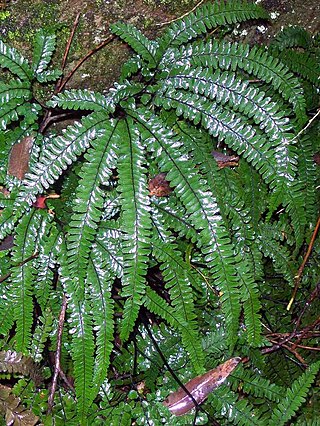
Adiantum hispidulum, commonly known as rough maidenhair fern or five-fingered jack, is a small fern in the family Pteridaceae of widespread distribution. It is found in Africa, Australia, Polynesia, Malesia, New Zealand and other Pacific Islands. Its fronds rise in clumps from rhizomes among rocks or in the soil in sheltered areas.
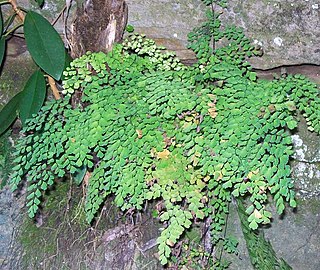
Adiantum aethiopicum, also known as the common maidenhair fern, is a small fern of widespread distribution, occurring in Africa, Australia, Norfolk Island and New Zealand.

Adiantum viridimontanum, commonly known as Green Mountain maidenhair fern, is a fern found only in outcrops of serpentine rock in New England and Eastern Canada. The leaf blade is cut into finger-like segments, themselves once-divided, which are borne on the outer side of a curved, dark, glossy rachis. These finger-like segments are not individual leaves, but parts of a single compound leaf. The "fingers" may be drooping or erect, depending on whether the individual fern grows in shade or sunlight. Spores are borne under false indusia at the edge of the subdivisions of the leaf, a characteristic unique to the genus Adiantum.

Adiantum raddianum, the Delta maidenhair fern, is one of the most popular ferns to grow indoors. It is native to South America and its common name comes from its shiny, dark leafstalks that resemble human hair. It typically grows about 17–19 in (43–48 cm) tall and up to 22 in (56 cm) wide. In the wild, it is found on forest floors, rock crevices, river banks, coastal cliffs, and basalt banks along trails and streams. The triangular fronds are semi-erect in the beginning then droop gracefully as they age and can be up to 12 inches (30 cm) long by 6 inches (15 cm) wide. The genus name Adiantum comes from the Greek word "adiantos", meaning "unwetted".

Adiantum venustum, the evergreen maidenhair or Himalayan maidenhair, is a species of fern in the genus Adiantum of the family Pteridaceae, native to China and the Himalayas. It is a slow to establish plant that usually grows on moist rocks and soil with a good amount of humus and dead leaves. It is very hardy, largely evergreen to -10 °C, when it becomes deciduous. It is also known as black Hansraj in India for its black stalks at the fronds.

Adiantum philippense,, also known as walking maidenhair fern, or black maidenhair, is a species of maidenhair fern (Adiantum) that is widely distributed through the southern hemisphere, notably Asia, Africa, and Madagascar.

Hymenophyllum rarum, the narrow filmy-fern, is a species of fern from the family Hymenophyllaceae. This thin-leaved fern is commonly found in New Zealand and Tasmania, growing in patches on rocks and is epiphytic on trees and tree ferns, growing in moist gullies or rainforests. A rather drought tolerant species often found at exposed sites ranging from coastal to montane areas. Forming extensive, interwoven and creeping patches with its thin long (creeping) rhizomes sparsely covered in red-brown hairs, easily recognised by its membranous grey-green fronds, the smooth margins of the pinnae, ultimate segments and indusia; and by the sunken sori in the uppermost segments of the uppermost pinnae. The species can be found throughout Tasmanian rainforests as well as occurring in New South Wales, Victoria and New Zealand on the North and South Islands as well as, Stewart, Chatham and Auckland Islands.
Adiantum × mairisii is a species of fern in the family Pteridaceae.
















